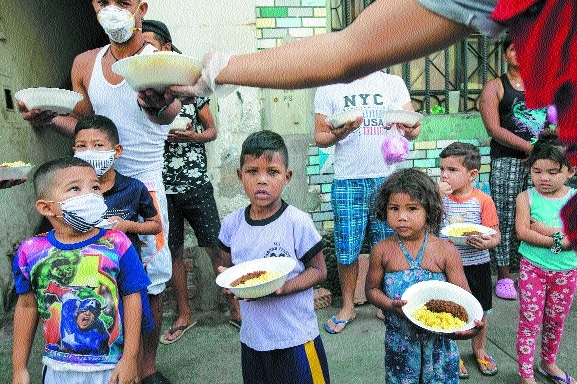‘About 11 mn could be driven into poverty in East Asia and Pacific’
| Date :01-Apr-2020 |

Venezuela’s migrants receive free meals from a Spanish NGO amid coronavirus restrictions in Lima, Peru on Monday. (AP/PTI)
By Lalit K Jha :
WASHINGTON
ABOUT 11 million people could be driven into poverty in East Asia and the Pacific as a result of the coronavirus pandemic that has impacted over 7,80,000 people and killed more than 37,000 globally, the World Bank has warned. The Washington-based global lender, in a report released on Monday, said that prior projections had estimated that nearly 35 million people would escape poverty in East Asia and the Pacific in 2020, including over 25 million in China alone.
“If the economic situation were to deteriorate further, and the lower-case scenario prevails, then poverty is estimated to increase by about 11 million people,” it said in its April 2020 Economic Update for East Asia and the Pacific ahead of the annual spring meeting of the International Monetary Fund and the World Bank. Growth in the developing East Asia and Pacific, the bank said, is projected to slow to 2.1 per cent in the baseline and to negative 0.5 per cent in the lower-case scenario in 2020, from an estimated 5.8 per cent in 2019. Growth in China is projected to decline to 2.3 per cent in the baseline and 0.1 per cent in the lower-case scenario in 2020, from 6.1 per cent in 2019.
Containment of the pandemic would allow for a sustained recovery in the region, although risks to the outlook from financial market stress would remain high, the report said. Noting that the COVID-19 shock will have a serious impact on poverty, the bank said the report estimates that under the baseline growth scenario, nearly 24 million fewer people will escape poverty across the region in 2020 than would have in the absence of the pandemic (using a poverty line of USD 5.50/day). Countries in East Asia and the Pacific that were already coping with international trade tensions and the repercussions of the spread of COVID-19 in China are now faced with a global shock, said Victoria Kwakwa, Vice President for East Asia and the Pacific at the World Bank.
“The good news is that the region has strengths it can tap, but countries will have to act fast and at a scale not previously imagined,” she said. Among the actions recommended by the report are urgent investments in national healthcare capacity and longer-term preparedness. It also suggests taking an integrated view of containment and macroeconomic policies. Targeted fiscal measures - such as subsidies for sick pay and healthcare - would help with containment and ensure that temporary deprivation does not translate into long-term losses of human capital.
“In addition to bold national actions, deeper international cooperation is the most effective vaccine against this virulent threat. Countries in East Asia and the Pacific and elsewhere must fight this disease together, keep trade open and coordinate macroeconomic policy,” said Aaditya Mattoo, Chief Economist for East Asia and the Pacific at the World Bank. The report said that the worsening in the COVID-19 pandemic and/or more severe/prolonged travel restrictions would have further negative impacts on tourism activity.
COVID-19 epidemics ‘far from over’ in Asia and Pacific, warns WHO
JAKARTA :
THE World Health Organisation warns that while attention has shifted to epicentres in Western Europe and North America, COVID-19 epidemics are “far from over” in Asia and the Pacific. Urging Governments at all levels in the region to stay engaged in efforts to combat the virus, WHO Regional Director for the Western Pacific, Dr Takeshi Kasai says, “This is going to be a long-term battle and we cannot let down our guard. We need every country to keep responding according to their local situation.”
He said the WHO realises there is no one-size-fits-all approach but there are common tactics. “Those are: finding, isolating and testing case early, tracing and quarantining contact quickly, and putting in place multiple public health interventions to place physical distance between people to slow and stop transmission.” Takeshi also cautioned that countries still need to prepare for large-scale community transmission.